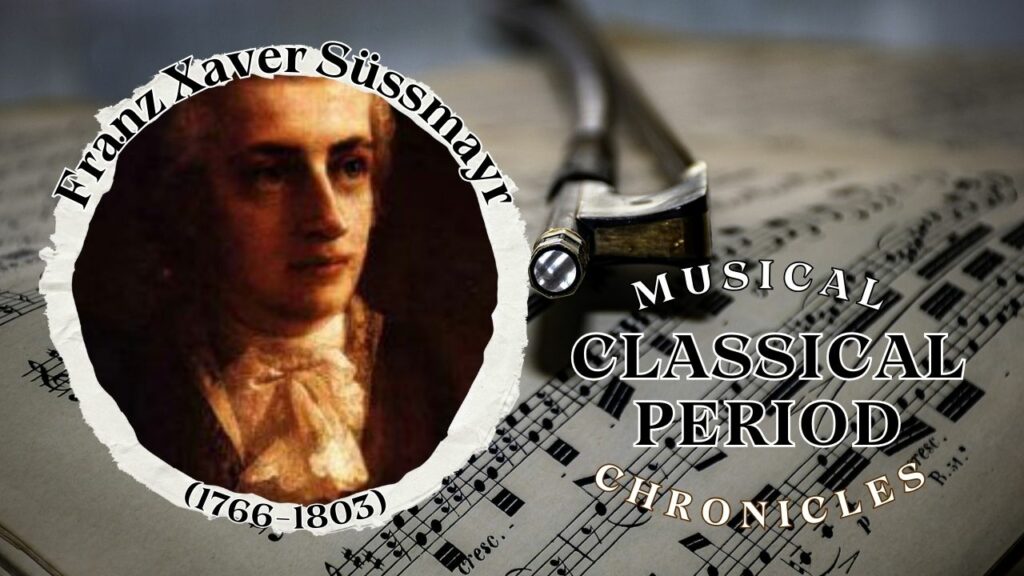
Franz Xaver Süssmayr (1766-1803)
In the Shadow of a Genius: Süssmayr’s Struggle for Artistic Identity
Franz Xaver Süssmayr, a young and aspiring composer, found himself standing at the crossroads of destiny when the illustrious Wolfgang Amadeus Mozart passed away. As Mozart’s trusted assistant, Süssmayr was bestowed with the monumental task of completing the master’s final composition—the renowned Requiem. While this offered an unparalleled chance for recognition, it also thrust him into the looming shadow of Mozart’s unparalleled genius.
Süssmayr, hailing from a modest background, had dreams of carving his niche in the world of classical composition. However, the unexpected death of Mozart placed him in a paradoxical position. On one hand, he held the key to completing a masterpiece that would solidify Mozart’s legacy, and on the other, he struggled to emerge from the overpowering influence that Mozart had over his artistic endeavors.
As he delved into the intricacies of finishing the Requiem, Süssmayr grappled with an internal conflict—a clash between his desire for recognition and the daunting responsibility of respecting Mozart’s artistic vision. The weight of being the one chosen to finish the composition, coupled with the pressure to seamlessly merge his style with Mozart’s, cast a long and intimidating shadow over Süssmayr’s artistic aspirations.
The requiem became a battleground where Süssmayr’s own creative identity fought for recognition amidst the echoes of Mozart’s brilliance. He faced the daunting challenge of not merely completing the musical notes but also imbuing them with a touch of his own creativity. This struggle for artistic identity became the linchpin of Süssmayr’s predicament, the focal point around which his professional journey unfolded.
In the face of this profound challenge, Süssmayr began questioning his place in the musical pantheon. Would he be forever defined as the custodian of Mozart’s final notes, or could he transcend this role and establish himself as an artist of merit? The struggle for artistic identity, intensified by the weight of Mozart’s legacy, painted a complex portrait of Süssmayr’s internal discord.
As we delve into Süssmayr’s story, the tension between homage and individuality will unravel, providing a nuanced understanding of the young composer’s quest for recognition buried under the daunting shadows of a musical giant.
Harmonic Inheritance: The Finishing Touch

Franz Xaver Süssmayr emerged into a world captivated by the echoes of Mozart’s genius. Born in Schwanenstadt, Austria, in 1766, Süssmayr’s early years were marked by an affinity for music that manifested at a young age. His innate talent drew the attention of those around him, and it wasn’t long before he found himself under the wing of the prodigious Wolfgang Amadeus Mozart.
His journey into the world of music began as a choirboy at the St. Stephen’s Cathedral in Vienna, where his early exposure to the grandeur of choral compositions left an indelible mark on his artistic sensibilities. Recognizing his burgeoning talent, Mozart took Süssmayr under his tutelage, opening doors to a world of musical exploration that would shape the young composer’s destiny.
Süssmayr’s apprenticeship with Mozart was a transformative period, marked by rigorous training and exposure to the rich tapestry of classical compositions. As he honed his skills under the master’s watchful eye, Süssmayr imbibed the intricacies of orchestration, counterpoint, and the delicate nuances of musical expression.
The young composer found himself entwined in Mozart’s artistic orbit during a time of immense creativity and innovation in Vienna, the cultural epicenter of Europe. The city pulsated with intellectual fervor, hosting a confluence of artistic minds that propelled the classical music scene to new heights. Süssmayr, immersed in this vibrant milieu, absorbed the influences of the era, contributing to the rich mosaic of his artistic formation.
His association with Mozart extended beyond the realm of professional mentorship; the two developed a close personal bond. Mozart, recognizing Süssmayr’s commitment and talent, entrusted him with tasks that extended beyond mere musical chores. The reciprocal respect and camaraderie between the two musicians painted a picture of collaboration that transcended the conventional master-apprentice dynamic.
However, the zenith of their collaboration, and the catalyst for Süssmayr’s subsequent artistic struggle, unfolded with Mozart’s untimely death in 1791. Entrusted with completing Mozart’s final opus, the Requiem Mass in D minor, Süssmayr stood on the precipice of an artistic journey that would define his legacy.
The completion of the Requiem, a profound and emotionally charged masterpiece, presented a dual challenge for Süssmayr. On one hand, he grappled with the weight of honoring Mozart’s vision, ensuring that his final composition remained true to the genius that had conceived it. On the other hand, Süssmayr faced the daunting task of infusing the composition with his artistic identity, transcending the role of a mere scribe to become a contributor to its artistic essence.
The intricacies of this challenge were further complicated by the mystery surrounding Mozart’s intentions for the unfinished portions of the Requiem. As Süssmayr delved into the composition, he navigated a delicate balance between preserving Mozart’s musical language and injecting his own interpretative nuances.
Süssmayr’s struggles with the Requiem unfolded against the backdrop of financial strain, a perennial companion in the lives of many artists. Despite his association with Mozart and the completion of the Requiem, Süssmayr found himself facing the perennial challenges of sustaining a livelihood as a composer. The complexities of his financial situation added an additional layer of pressure to an already intricate artistic journey.
Regardless of these challenges, Süssmayr’s compositions, while overshadowed by the luminosity of Mozart’s legacy, began to garner recognition. His works, including operas, symphonies, and chamber music, reflected a unique amalgamation of classical sensibilities and the evolving stylistic nuances of the early 19th century.
Süssmayr’s career took him across Europe, from Vienna to Prague, and his artistic journey unfolded in the midst of a changing musical landscape. The transition from the Classical to the Romantic era brought new challenges and opportunities, and Süssmayr, although rooted in the traditions of his mentor Mozart, demonstrated an ability to adapt to the evolving currents of musical expression.
As we explore the beginnings of Süssmayr’s artistic odyssey, we encounter a composer navigating the intersections of artistic legacy, financial constraints, and the evolving tapestry of musical innovation. His journey, marked by collaboration, creative tension, and personal challenges, lays the foundation for a nuanced understanding of the artist behind the shadows of Mozart’s Requiem.
News of War
We interrupt this program for a special news bulletin.
In a dramatic turn of events, Vienna, the cultural heart of Europe, finds itself plunged into a state of crisis as the Napoleonic Wars unfold. The serene city known for its artistic richness is now caught in the grip of conflict, with the echoes of war reaching every corner.
Napoleon Bonaparte’s ambitions have led to widespread upheaval, and Vienna, once a haven for artists and musicians, now grapples with the harsh realities of conflict. The city’s vibrant cultural scene is overshadowed by the clamor of battle, and its inhabitants face an uncertain future.
The streets, once filled with the harmonious melodies of classical compositions, now resonate with the unsettling sounds of war. The Viennese, accustomed to the refined notes of symphonies and operas, find themselves confronted with a new and dissonant soundtrack – the thundering cannons, the trampling of soldiers, and the anguished cries of those caught in the crossfire.
Composers, including Franz Xaver Süssmayr, now face the daunting challenge of creating immersed in the chaos. The usual patrons who once supported the arts are preoccupied with the harsh realities of conflict. The sanctuaries of creativity are transformed into makeshift shelters, and the rhythm of life in Vienna stumbles under the weight of uncertainty.
As Süssmayr navigates this tumultuous period, his compositions bear witness to the shifting tides of history. The music that emerges reflects not only personal struggles but also the collective upheaval of a city in crisis.
And now, back to our scheduled program, where we delve into the life and work of Franz Xaver Süssmayr, a composer whose melodies rise above the discord of war.
Harmony Amidst Turmoil: The Musical Resilience of Franz Xaver Süssmay
In the midst of Vienna’s turmoil, Franz Xaver Süssmayr found himself ensnared in the web of historical chaos. The once-thriving cultural hub had become a theater of war, the rhythm of daily life disrupted by the drumbeats of conflict. Süssmayr, like many of his contemporaries, grappled with the challenges of creating art engulfed in the cacophony of battle.
Süssmayr showed early promise as a musician. His talents captured the attention of Antonio Salieri, one of the prominent figures in Vienna’s musical landscape. Under Salieri’s guidance, Süssmayr honed his skills and developed a deep appreciation for the classical tradition that flourished in the city.
Süssmayr’s compositions reflected the influences of his time, blending the elegance of the Classical era with a sensitivity to the emotional currents of the moment. However, the Napoleonic Wars brought a stark shift in Vienna’s fortunes. The city’s grandeur faded as conflict cast its shadow, forcing artists like Süssmayr to confront a harsh reality.
With traditional patrons preoccupied by the demands of war, Süssmayr faced financial hardships. The familiar venues that once resonated with the notes of his compositions were repurposed for wartime needs. Yet, despite the adversities, Süssmayr’s commitment to his craft endured. His music became a testament to resilience, an art form that defied the turmoil surrounding its creation.
As the war raged on, Süssmayr’s compositions bore witness to the collective pain and longing of a city in distress. His melodies whispered tales of both personal struggle and the broader narrative of a society caught in the throes of historical upheaval. In these compositions, listeners could discern echoes of resilience, a refusal to be silenced by the dissonance of war.
Süssmayr’s work during this period included symphonies, chamber music, and operas that sought to capture the essence of a city in transition. The usual grandeur of Vienna’s cultural scene may have dimmed, but Süssmayr’s music became a beacon, offering solace and artistic expression amid the uncertainties of wartime life.
It is within this intricate tapestry of historical events that Süssmayr’s legacy endures. His compositions, conceived in times of war, encapsulate the spirit of a bygone era. Each note is a brushstroke on the canvas of Vienna’s history, a testament to the resilience of creativity in the face of adversity.
And so, as we delve into the intricate details of Franz Xaver Süssmayr’s life and work, we uncover a narrative that transcends the boundaries of time. His journey becomes a window into an era marked by both strife and artistic brilliance, reminding us that even surrounded by the chaos of war, the human spirit has the power to create beauty and meaning.
Closing Crescendo: The Legacy of Franz Xaver Süssmayr
As the symphonic notes of Franz Xaver Süssmayr’s life reached their final cadence, the echoes of his compositions lingered in the air. The intricate melodies he crafted reflected both his artistic brilliance and the complexities of his personal struggles.
Franz Xavar Sussmayr emerged as a significant figure in the Classical era. His early years were marked by a relentless pursuit of musical excellence, and he found himself entwined with the flourishing Viennese musical scene. Under the tutelage of renowned composer Wolfgang Amadeus Mozart, Süssmayr developed a deep appreciation for the nuances of orchestration and composition.
However, the strains of financial hardship accompanied Süssmayr throughout his career. Despite contributing to Mozart’s famous unfinished Requiem, Süssmayr faced financial woes that often hindered the full realization of his creative potential. His compositions, ranging from symphonies to chamber music, reflected both the grandeur of the Classical period and the personal turbulence he experienced.
The Napoleonic Wars were not a mere pause but a disconcerting intermission marked by external upheavals. The socio-political landscape of Europe witnessed significant transformations during Süssmayr’s lifetime, including the French Revolution. These seismic events impacted artists, often diverting attention from cultural pursuits to the pressing issues of the day.
üssmayr’s story reveals the intricate details of his compositions and the unique blend of influences that shaped his work. Süssmayr’s dedication to his craft and his unwavering commitment to musical expression became a testimony to the enduring spirit of creativity in the face of adversity.
The resolution of Süssmayr’s narrative carries the weight of both triumph and tragedy. His legacy, though clouded by financial constraints and overshadowed by the titans of his time, remains a testament to the indomitable human spirit in the pursuit of art. As the final notes of his life’s symphony fade away, they seamlessly transition into the harmonious overture of Maria Theresia von Paradis, the next luminary in our musical journey.
Return to the Classical Period Chronicles home page.
